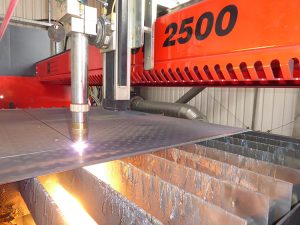Littleborough-based Ken Mills Engineering (KME) Ltd has upgraded its Kerf plasma cutting machine with a new and larger RUR2500p. Replacing its predecessor, the new RUR2500p has an 8 x 2 m bed and a more powerful and precise Lincoln Electric Spirit II 275 A plasma unit with the very latest Ultrasharp cutting technology.

Alluding to why the company replaced a machine that has delivered exceptional performance levels, director Andy Mills says: “Our components are primarily small-to-medium batches that are cut from single sheets, which rarely exceed the 4 m bed length of the previous machine. We recognised that by increasing the bed length we could load one side of the machine while parts are being cut on the other end of the bed. This pendulum loading has effectively eliminated non-productive set-up times and reduced overall production times by an additional 50%.
“The new Kerf RUR2500p has the very latest Ultrasharp cutting technology and this has improved the precision and surface finishes of the profiles and holes we cut,” he continues. “Additionally, there is less cleaning, no secondary hand finishing and less dross from the process.”
As well as offering precision levels in the ±0.5 mm range, the Lincoln Electric Spirit II plasma unit has the capacity to pierce materials up to 35 mm thick.
Concluding on the benefits of the machine acquisitions, Mills says: “In combination with a new press brake, the Kerf machine is saving us upwards of £250,000 a year in subcontract costs. Added to this, we are saving around £150,000 a year in material, and there are fewer transport costs as we don’t deal with subcontractors.”
For further information www.kerfdevelopments.com













